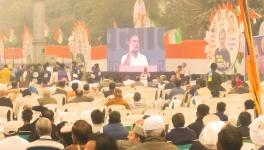Run-up to 2024 Election: 2023 Feels Like 2013 Again!
File Photo
It is uncanny, but the feeling of déjà vu persists in the run-up to the 2024 general election—doesn’t 2023 feel like 2013 all over again? There’s a leader in the making with a national stride, preparing to take on the Narendra Modi government just like the latter did in 2013 to take on the then-Manmohan Singh-led UPA II; there’s a swell of chatter about cronyism, favouritism and corruption—and, of course, the dismal economic situation.
Let’s begin with the just concluded first phase of Rahul Gandhi’s Bharat Jodo Yatra, a march to spread love and brotherhood in a country seized by hate mongering of the Rashtriya Swayamsevak Sangh-led Hindutva brigade, as Congress leaders say. But it had all the hallmarks of the former party president taking the lead in becoming the Opposition’s face in the next year’s Lok Sabha election.
Remember 2013, when Gujarat’s then-chief minister Modi unleashed a media blitz wherein he was hailed as the ‘Development Man’ and ‘Iron Man’ who had transformed his state—with some dodgy and exaggerated statistics—and who could change the country.
So, where do the comparisons begin and end in the 2013-2023 sweepstakes? It’s not just about Rahul’s ‘Love Parade’ trying to beat the RSS-BJP Hindutva’s divisive hate campaign; there’s more.
Modi had to trample over BJP biggies like the disgruntled LK Advani and Sushma Swaraj to stake his claim as the leader. In Rahul’s case, he has his party on his side, but not all non-BJP parties see him as their chosen leader.
At the conclusion of the Yatra in Srinagar a few days ago, only eight out of the 23 parties invited by the Congress attended the curtain call with regional heavies like Trinamool’s Mamata Banerjee, SP’s Akhilesh Yadav, CPI (M), Mayawati’s BSP, Sharad Pawar’s NCP, Shiv Sena’s Uddhav Thackeray, among others, absent.
The reason was clear: the Opposition parties were reluctant to give Rahul the pre-eminent position of the natural leader of an anti-BJP coalition, as leaders like Banerjee and Pawar see themselves as equals.
However, it’s equally true that many BJP and non-Congress allies refused to endorse Modi as their prime ministerial candidate in 2013—most notably Janata Dal (United)’s Nitish Kumar, who even broke the alliance with the BJP in Bihar saying he refused to accept a leader whose idea and policy is divisive.
The BJP’s oldest ally, Shiv Sena, was equally vociferous when it warned of a Mahabharata if the BJP ignored its allies in selecting the prime ministerial candidate. The Sena was livid with Modi for reaching out to its pet hate, the MNS’s Raj Thackeray.
In a funny way, isn’t Rahul cloning Modi’s 2013 cult personality and image by building his own profile and image on the national stage in 2023?
Next, now what else took the lead in building the tsunami-like political movement that dislodged the two-term Congress-led UPA government? The India Against Corruption movement, led by Anna Hazare and Arvind Kejriwal, saw Indians demanding clean politics through the much-touted Lok Pal Bill but which all but split soon with Anna Hazare and Arvind Kejriwal going their own ways.
Funny, but the bombshell Hindenburg Report, which accuses billionaire Gautam Adani of “brazen stock manipulation and accounting fraud over the course of decades”, has come out of the blue.
Adani, who rose dizzyingly in the last nine years ever since Modi became PM, to become the world’s third richest man and the richest Indian, was bagging lucrative billion-dollar contracts in ports, airports, mining, power, gas and infrastructure.
While both Modi and Adani deny cronyism and favouritism, even as state-owned banks and the LIC invested in Adani’s companies, Hindenburg alleged how the billionaire used Mauritius-based funds to conceal his family holdings in companies. How his brother Vinod Adani moved billions of dollars through Mauritius into Adani companies as the SEBI, RBI, finance ministry and even courts turned the other way.
For instance, it alleged that eight cases against Adani companies in the Supreme Court strangely always went to a Bench led by then-Justice AK Mishra and the verdicts were in his favour.
As the stock market bloodbath wiped off more than $100 billion of Adani Group’s market value in the aftermath of the Hindenburg Report and knocked him off the global list of 10 richest men, India’s regulatory authorities and law and justice are under international scrutiny.
For Modi, this could not have come at a worse time just when India assumed the G20 presidency and world leaders who oversee 85% of the world GDP would focus on the country. They will be watching with a hawk’s eye how the Modi government and its various governing institutions will handle the Adani ‘discrepancies’ in the financial market.
The reverberations of the report, however, are yet to filter down to the people as the mainstream media has typically gagged itself to ensure none of them affect the government, The joke doing the rounds is that Adani’s stocks can never hit rock bottom as much as the mainstream media has fallen.
There’s not a word in the mainstream media that Adani’s son Karan is married to the daughter of famous corporate lawyer Cyril Shroff, a member of the SEBI’s committee on corporate governance and insider trading and a legal adviser to the Adani Group.
It’s only now that Opposition members are insisting that Shroff recuse himself if the SEBI panel investigated Adani following the report. Hindenburg also mentioned that Vinod’s daughter is married to the son of fugitive diamond merchant Jatin Mehta, who allegedly defrauded a consortium of banks of almost Rs 7,000 crore.
This should have set the media on fire demanding accountability and calling out conflict of interest but there has been an embarrassing silence from top editors and primetime anchors.
The Adani-Modi jodi is best exemplified in the takeover of the Mumbai International airport run by GVK Reddy in 2020. After Rahul Gandhi, in his speech in Parliament, questioned the manner of the airport’s sale to Adani, two days ago, Sanjay Reddy, the scion of GVK industries, denied there was a hostile takeover of the airport by Adani. It must be said here that Reddy was quoted on the new Adani channel, NDTV!
In June 2020, the CBI registered a case against GVK, the company was raided in July, with the ED hot on the heels registering a money laundering case a week later, and by August 31, GVK signs the agreement with Adani to hand over the Mumbai airport.
On the other hand, Bangladesh is reportedly now demanding to renegotiate its deal with Adani for buying electricity from its Godda power plant. As per reports, it has said it was paying three times the price than power available from other coal-based power plants in India. The deal came during Modi’s visit to Bangladesh in June 2015.
Imagine if these two incidents had happened during the UPA regime.
Perhaps, it’s this deafening silence that’s a dead giveaway of the government’s hold over the media and also underlines the stark difference between the media attention in 2013 and 2023.
In 2013, the economic situation was a defining factor for voters. Remember Modi’s high-octane ‘Development Man’ campaign of glitzy roads and rail network, jobs and subsidies, growth and upward mobility for the young as opposed to the UPA II’s double-digit inflation, stalled projects and tardy development and corrupt governance.
It’s another matter that the UPA did fare better than the Modi government in its last nine years. According to a UNDP report, both UPA I and II pulled 369 million people out of poverty. In 2005-06, after the Congress wrested power from the AB Vajpayee government, poverty stood at 640 million people, or 55% of the population. It was reduced to almost half after a decade of UPA rule.
Yet when all indicators in the past five years show a downward slide in the economic and development index, the media has only pushed the Acche Din to Amrit Kaal rhetoric. All this as the catastrophic demonetisation, the unplanned lockdown and a restrained stimulus played out—salaried jobs plunged, small traders were wiped out and nutritional levels dived in rural India.
Last month, an Oxfam International report released at the World Economic Forum, Davos, revealed that India’s top 1% owned more than 40.5% of its total wealth in 2021 while the bottom half of the population shared a mere 3% of the wealth.
The Gujarat riots have come back to haunt Modi again with the two-part BBC documentary released last month or not accepted “sealed cover jurisprudence” where the government and its investigating agencies file their reports on corruption cases like the Rafale deal or money laundering cases in sealed covers citing national security.
If you only look at the ‘big bad’ words of 2013—CAG and NPAs—there’s not a murmur in the media. For instance, only recently, a high standing parliamentary panel summoned CAG officials to ask why there was “unreasonable” delay in tabling annual reports and audited accounts of various autonomous bodies, ministries and departments and public undertakings. Of course, CAG chief GC Murmu is a trusted officer from the Gujarat cadre who was the principal secretary to Modi in Gujarat.
As for NPAs, public sector banks have been writing off even more giant dud loans in Amrit Kaal. RBI data in 2021 shows that gross NPAs have gone up three times more in the NDA rule. Gross NPAs of public sector banks from 2014-15 to 2019-20 stood at nearly Rs 18.28 lakh crore, up by nearly Rs 5 lakh crore from 2008-09 to 2013-14 in the UPA rule. Banks wrote off bad loans of Rs 6,83,388 crore in the past six years.
Imagine if questions are raised -- as in 2013. For, if nothing else, it’s questions that enlighten us.
Will a truthful, unbiased media bring about a change again in 2024? Or is this the age of pseudo-reality?
The writer is an independent journalist. The views are personal.
Get the latest reports & analysis with people's perspective on Protests, movements & deep analytical videos, discussions of the current affairs in your Telegram app. Subscribe to NewsClick's Telegram channel & get Real-Time updates on stories, as they get published on our website.





















